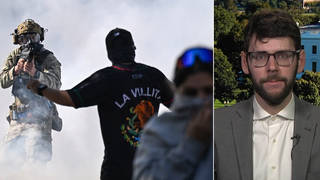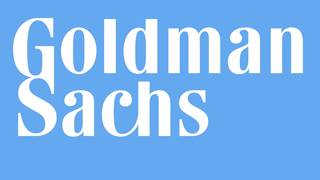
Guests
- Nomi PrinsEconomist, journalist and senior fellow at Demos. Her latest book, coming this fall, is It Takes a Pillage: Behind the Bonuses, Bailouts, and Backroom Deals from Washington to Wall Street. She has worked for Goldman Sachs and Bear Sterns, and her earlier books include Other People’s Money and Jacked: How Conservatives are Picking Your Pocket.
The Guardian newspaper reports staff at Goldman Sachs can look forward to the biggest bonus payouts in the firm’s 140-year history after a spectacular first half of the year, sparking concern that the big investment banks which survived the credit crunch will derail financial regulation reforms. We speak to Nomi Prins, a former managing director for Goldman Sachs in New York, about the possible record bonuses, President Obama’s proposed reforms of the financial regulatory system and the “The Big Bank Bailout Payback Bamboozle.” [includes rush transcript]
Transcript
AMY GOODMAN: We turn now to what’s happening here at home, the financial crisis. Juan?
JUAN GONZALEZ: Well, last week, President Obama presented his vision for reforming the US financial regulatory system, saying the new regulations would prevent the kind of abuses that created the current crisis. He said they would fundamentally address the, quote, “crisis of irresponsibility [that] took root from Wall Street to Washington to Main Street.” The administration’s proposal is laid out in an eighty-five-page white paper that Obama described as outlining the most sweeping overhaul of the system since the reforms following the Great Depression.
PRESIDENT BARACK OBAMA: It is an indisputable fact that one of the most significant contributors to our economic downturn was a unraveling of major financial institutions and the lack of adequate regulatory structures to prevent abuse and excess. A culture of irresponsibility took root from Wall Street to Washington to Main Street. […]
We were facing one of the largest financial crises in history, and those responsible for oversight were mostly caught off guard and without the authority needed to address the problem.
It’s time for that to change. I am proposing that the Federal Reserve be granted new authority and accountability for regulating bank holding companies and other large firms that pose a risk to the entire economy in the event of failure. […]
As part of these reforms, we will dismantle the Office of Thrift Supervision and close loopholes that have allowed important institutions to cherry-pick among banking rules. We will offer only one federal banking charter, regulated by a strengthened federal supervisor. We’ll raise capital requirements for all depository institutions. Hedge fund advisers will be required to register with the SEC.
We’re also proposing comprehensive regulation of credit default swaps and other derivatives that have threatened the entire financial system. And we will require the originator of a loan to retain an economic interest in that loan, so that the lender — and not just the holder of a security, for example — has an interest in ensuring that a loan is actually paid back. By setting commonsense rules, these kinds of financial instruments can play a constructive, rather than destructive, role.
JUAN GONZALEZ: The proposal also includes the creation of a Consumer Financial Protection Agency. In his weekly radio address and internet address Saturday, President Obama defended the proposed agency, saying it would set harsh new rules to stop deceptive lending practices.
PRESIDENT BARACK OBAMA: And one of the most important proposals is a new oversight agency called the Consumer Financial Protection Agency. It’s charged with just one job: looking out for the interests of ordinary Americans in the financial system. This is essential, for this crisis may have started on Wall Street, but its impacts have been felt by ordinary Americans who rely on credit cards, home loans and other financial instruments.
It’s true that this crisis was caused in part by Americans who took on too much debt and took out loans they simply could not afford. But there are also millions of Americans who signed contracts they didn’t always understand, offered by lenders who didn’t always tell the truth. […] This new agency will have the responsibility to change that.
AMY GOODMAN: Economist, journalist, Demos senior fellow and former investment banker Nomi Prins thinks that Obama’s new plan is not such a sweeping overhaul of the financial system, after all. She is the author of the forthcoming book It Takes a Pillage: Behind the Bailouts, Bonuses, and Backroom Deals from Washington to Wall Street. Her latest article is an assessment of Obama’s reform proposals. It’s called “Obama’s New Economic Plan: The Good, the Bad and the Weak.” It was just published in Mother Jones. She joins us here in our firehouse studio.
Before you comment on the whole plan that was laid out, this latest news. You used to work at Bear Stearns, and you worked at Goldman Sachs. Goldman Sachs has just said that their staff can look forward to the biggest bonus bailouts in the firm’s 140-year history. How is this possible?
NOMI PRINS: It is possible because our government has chosen to effectively give Goldman the money to do that, in a number of different ways. One is the $10 billion that it got through the TARP program, which both Goldman and the government want us to believe is the only bit of federal subsidy it has gotten, which is why, when it said it would pay back the TARP program, it was all this gesture of “we’re healthy, we’re good, we’re paying it back, we didn’t really need it,” but really they didn’t want government oversight attached to it, not that there was a lot.
The bigger amount of money that has gone to Goldman has come through $12.9 billion from the AIG bailout that went straight to Goldman, its biggest counterparty; $28 billion worth of FDIC-backed guaranteed debt, meaning the FDIC put up a program last fall, and it said, “For banks that deal with consumers” — not banks that deal with multibillion-dollar companies or investors, but people — “we will provide guarantees for debt,” which means that those companies can raise debt to help consumers cheaply. Goldman said, “Alright, fine, we’ll take some of that.” And they took $28 billion worth of that, and they have up to $35 billion that they can take under the FDIC program that was never meant for a company like Goldman Sachs.
In addition, there is a ton of money, there are trillions of dollars at the Fed, not all of that went to Goldman, but that has secretly gone to a number of banks in the system, of which Goldman is one, for which the Fed refuses to disclose any information or any detail, which also goes into this. So when Goldman says — has the nerve to say, feels entitled to say — that it’s going to pay its bankers record bonuses after the travesty that it and other banks have created in the markets, it is on the back of federal subsidies that effectively come from our pockets.
JUAN GONZALEZ: Well, I think you’ve made the point that the $780 billion-odd TARP money is only a small portion, that the actual federal support for the banking industry is about $13 trillion?
NOMI PRINS: That’s exactly right. The media has constantly focused, and Wall Street has been very happy about this focus, on this measly — and I say “measly” — $700 billion worth of TARP money that Congress allowed to be allocated last October. And that money has gone out to a number of banks, including Goldman and JPMorgan and Bank of America, Citigroup and other banks.
But in addition to that, there have been over two-and-a-half trillion dollars’ worth of guarantees and other types of subsidies from the Treasury Department; over seven-and-a-half trillion from the Federal Reserve, which a lot has gone through the bank at — the New York Federal Reserve during the Tim Geithner period, when he was running it, as well as the Federal Reserve component in Washington; and then all these extra FDIC guarantees, which have the backing of the Fed and the Treasury Department.
So we’re talking about almost 13.6, actually, now — the count keeps going up every time I look at it — trillion dollars’ worth of subsidization of the banking industry. $700 billion is a part —- it’s a big part, but there are so many more trillions, that just do not get the right coverage and the right perspective from the media, that exists, that are secret. Some are not. But it’s a lot, a lot of money. It could basically pay for every single mortgage in this country and healthcare and subsidizing student loans. So when it wants to, the government can come up with a way to subsidize what it wants to subsidize. It chose to subsidize the banking industry.
AMY GOODMAN: Nomi Prins, let’s talk about how this fits into what President Obama just laid out this past week.
NOMI PRINS: Well, so, Obama said a couple of things in his proposal, his eighty-eight-page white paper that will be created into a big congressional 400— or 500- or 600-page paper for debate probably later in some sort of an act. There were three things that he basically proposed.
When we talked — you had a clip just now on the Consumer Financial Protection Agency. That is a good idea. It is high time there is some agency in Washington that is on par with the SEC or the Fed or other regulatory bodies, if this agency can be given that kind of enforcement and power. The agency that would look at mortgage loans being more transparent and safer for individuals, potentially capping credit cards, and most importantly, making sure that the banks who issue the loans and who also package them up and sell them globally and make tons of money on it actually have to keep some of those loans and some of those packages on their own books, so if there are losses, they get hit with the losses — that’s the part that the banking industry has gone up in arms about. This one agency is the part that the Wall Street banks have been most upset about, which is why we know that it could be the best part of his proposal, if it gets the play and the enforcement capabilities it deserves. But it’s going to be a knock-down, drag-out fight.
The other things that this proposal did was a little bit of a shuffling of deck chairs, unfortunately, in the regulatory system. We had something called an Office of Thrift Supervision, which was effectively responsible for monitoring S&Ls. And the most problematic S&L, which was AIG — now, we think of AIG as an insurance company slash hedge fund slash a thing that took $220 billion worth of federal subsidies because its systemic failure would ruin the world. However, AIG is actually classified as an S&L. The Office of Thrift Supervision, which is not equipped to deal with an S&L of the complexity of an AIG, which isn’t really one, failed in that responsibility. They’re being deleted, and they and another regulatory body in Washington, the Office of Comptroller of the Treasury, will be consolidated into a new regulatory agency called the National Banking Supervisor. Those are two things.
JUAN GONZALEZ: Well, I’d like to ask you about the — I guess the nuclear bomb of all this financial crisis, which was the question of all of these unregulated derivatives and credit default swaps that were occurring basically outside the banking system and that the Obama administration is now claiming that it will attempt to regulate. But you’re a little skeptical about what you’ve seen so far of the proposal, right?
NOMI PRINS: The proposal has said, quote, “it will regulate standardized OTC,” which are over-the-counter, these types of derivatives — “standardized” meaning the ones that basically are so generic they’re not actually that harmful.
What was harmful in this particular saga were things called CDOs, which were collateralized debt obligations, which were packages of derivatives and all sorts of other things combined with loans and other types of securities. And two trillion of those were issued. But the leverage, or the amount that banks could borrow on the back of that, ranged from ten to thirty times. So a $2 trillion set of stuff became something like a $20 trillion to $60 trillion set of risk. Those are things that will not be under the Obama plan for regulation.
And again, these are things that have been lobbied substantially by the banking industry. “Do not take the least generic things, the most complex things, that we can make the most amount of money out of, because neither the regulators nor our investors, frankly, really understand what we’re doing in them. Do not take those away from us.” And the administration was like, “OK, but we’re going to create this sort of sweeping standardized regulatory system for some of the derivatives.” Will it help a little bit? Yes. Will it help the real problem? No, it will not.
AMY GOODMAN: You referred to this, Nomi, in discussing Goldman Sachs, but the bigger picture of what you call the “big bank bailout payback bamboozle”?
NOMI PRINS: Well, this is part of the $13.6 trillion versus the $700 billion. A couple weeks ago, ten banks said — or were allowed by the Treasury Department to pay back all or a portion of the TARP money they had received. One was Goldman, that had $10 billion; one was JPMorgan Chase, that had $25 billion; and so forth. The collective money of those ten banks was $68 billion they would be paying back. They happen to owe $229 billion.
The media didn’t really mention that part. They only mentioned, “Oh, the banks are paying back this money. Things must be healthy. The financial system must be stabilizing. And all is sort of good.”
The reality is, they owe $229 billion just from the FDIC guarantees they were able to use and from the AIG money. That does not include the trillions of dollars — and this is the biggest problem in all of this — that are on the Fed’s books that we do not know how it was divided out among these banks. So we know of $229 billion. We also know there are multiple trillions of dollars on the Fed’s books that went out to these and other banks. We don’t know how much, because they will not disclose that information.
AMY GOODMAN: Why aren’t they forced to?
NOMI PRINS: Well, this is the biggest part of both the overhaul that Obama has mentioned and also the fact that the Fed is the most powerful regulator already. They’re responsible for the banking system. They’re responsible for subsidizing it.
There have been multiple FOIA requests, Freedom of Information Act requests, to the Fed from bodies between — I worked with The Nation to try to get information, through to Bloomberg to Fox. The entire spectrum of media has tried to get information from the Fed on these loans, and the Fed has basically said — and Bernanke has said this to the Senate and to the House — that this would actually be dangerous. It would be dangerous to give this information out, because somehow if people knew, it would create some larger catastrophic situation.
The reality is, we kind of know who these banks are. The bigger banks have the tightest relationship with the Fed. They actually own portions of the Fed, because they actually own shares in the Fed. They have an incredibly symbiotic relationship. And they’ve gotten trillions of dollars of subsidies. We don’t know what the Fed won’t say. The Fed hasn’t been made to say.
JUAN GONZALEZ: I’d like to ask you one last question. Both Morgan Stanley and Goldman Sachs were allowed in September, right in the midst of the crisis, to turn themselves into bank holding companies overnight. Could you explain the significance of that?
NOMI PRINS: Yeah. There was a chaotic Sunday evening, September 21st, where Goldman Sachs and Morgan Stanley noted that Lehman Brothers had just fallen apart, that they actually did not have enough money to pay their ongoing day-to-day debts. They were literally about to become insolvent, one or both of these institutions.
The only thing that they could do is push the Fed to allow them to become bank holding companies, which would give them access to federal subsidies. Just legally, in terms of the legislative construct, if they get to be a bank holding company, they get more access to our money. So they said, “OK.” The Fed, at night, on a Sunday, without even waiting for the five-day mandatory antitrust period, decided “OK, fine.” That enabled Morgan Stanley and Goldman Sachs to become bank holding companies, to get under the public subsidy tent, and to get a lot of this money, the FDIC guarantees, the Fed backing and everything else. And that was the Fed’s decision. They could have said no. They said, “Come on, and we’ll do it really quick. Just tell us where to sign.”
AMY GOODMAN: Nomi Prins, we want to thank you for being with us. Nomi Prins is an economist. She used to work with Goldman Sachs and Bear Stearns; now she is exposing them. Her article, “The Big Bank Bailout Payback Bamboozle,” appears in Mother Jones, and her article “Obama’s New Economic Plan: The Good, the Bad and the Weak” is at Alternet.org.












Media Options